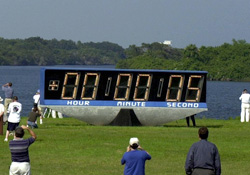
The countdown clock is one of the most-watched timepieces in the world. On this page, you'll learn how the countdown operates, and what milestones to watch for during our live launch coverage.
Image to left: Spectators gather on the grounds in front of the countdown clock during a space shuttle launch. Credit: NASA
Here are some of the key events that take place at each milestone after the countdown begins. Note: Event times and lengths are approximate and subject to change.
T-43 hours and counting
The Shuttle Test Director performs the traditional call to stations and the countdown clock is activated.
|
- Begin final vehicle and facility close-outs for launch
- Check out backup flight systems
- Review flight software stored in mass memory units and display systems
- Load backup flight system software into the orbiter's general purpose computers
- Remove middeck and flight deck platforms
- Activate and test navigational systems
- Complete preparation to load power reactant storage and distribution system
- Complete flight deck preliminary inspections
|
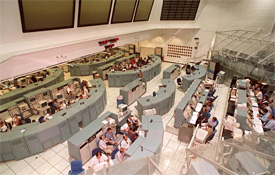 Image to right: The space shuttle launch team seated in Kennedy's Firing Room 1.
Image to right: The space shuttle launch team seated in Kennedy's Firing Room 1.
Credit: NASA
T-27 hours and holding
This is the first built-in hold and typically lasts four hours.
|
- Clear launch pad of all non-essential personnel
|
|
T-27 hours and counting
|
- Begin operations to load cryogenic reactants into the orbiter's fuel cell storage tanks
|
T-19 hours and holding
This built-in hold typically lasts four hours.
|
- Demate the orbiter's midbody umbilical unit
|
|
T-19 hours and counting
|
- Begin final preparations of the orbiter's three main engines for main propellant tanking and flight
- Fill launch pad sound suppression system water tank
- Resume orbiter and ground support equipment close-outs
- Close out the tail service masts on the mobile launcher platform
|
T-11 hours and holding
This built-in hold varies in length, but typically lasts 12 to 13 hours.
|
- Flight crew equipment late stow
- Move rotating service structure to "park" position
- Activate the orbiter's inertial measurement units and communications systems
- Perform ascent switch list
|
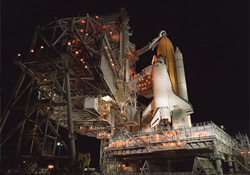 Image to right: The rotating service structure is rolled slowly into the "park" position, revealing Space Shuttle Atlantis as the launch countdown for STS-98 enters its final hours. Credit: NASA
Image to right: The rotating service structure is rolled slowly into the "park" position, revealing Space Shuttle Atlantis as the launch countdown for STS-98 enters its final hours. Credit: NASA
| T-11 hours and counting
|
- Activate the orbiter's fuel cells
- Clear the blast danger area of all nonessential personnel
- Switch the orbiter's purge air to gaseous nitrogen
|
T-6 hours and holding
This built-in hold typically lasts two hours.
|
- Launch team verifies no violations of launch commit criteria before loading the external tank with propellants
- Clear pad of all personnel
- Chill-down of propellant transfer lines
- Begin loading the external tank with about 500,000 gallons of cryogenic propellants
|
| T-6 hours and counting
|
- Finish filling the external tank with its flight load of liquid hydrogen and liquid oxygen propellants
|
T-3 hours and holding
This built-in hold typically lasts two hours.
|
- Perform inertial measurement unit preflight calibration
- Align Merritt Island Launch Area (MILA) tracking antennas
- Final Inspection Team proceeds to the launch pad to conduct a detailed analysis of the vehicle as the team walks up and down the entire launch tower
- Closeout Crew proceeds to the launch pad to configure the crew module for countdown and launch and assist the astronauts with entry into the orbiter
|
| T-3 hours and counting
|
- Crew departs for the launch pad and, upon arriving at the pad, begins entry into the orbiter via the White Room
- Complete close-out preparations in the launch pad's White Room
- Check cockpit switch configurations
- Astronauts perform air-to-ground voice checks with Launch Control (Kennedy Space Center) and Mission Control (Johnson Space Center)
- Close the orbiter's crew hatch and check for leaks
- Complete White Room close-out
- Close-out crew retreats to fallback area
|
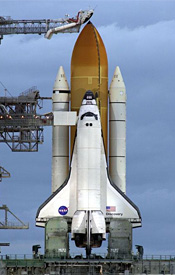
T-20 minutes and holding
This built-in hold typically lasts 10 minutes.
|
- Shuttle Test Director conducts final launch team briefings
- Complete inertial measurement unit preflight alignments
|
Image to right: Space Shuttle Discovery waits to launch on mission STS-103. At the top is the external tank gaseous oxygen vent arm system with the vent hood (sometimes called the "beanie cap") poised above the external tank. Extending toward the cabin of the orbiter below is the orbiter access arm, with the White Room at the end. Credit: NASA
| T-20 minutes and counting
|
- Transition the orbiter's onboard computers to launch configuration
- Start fuel cell thermal conditioning
- Close orbiter cabin vent valves
- Transition backup flight system to launch configuration
|
T-9 minutes and holding
This is the final built-in hold, and varies in length depending on the mission.
|
- The Launch Director, Mission Management Team and Shuttle Test Director poll their teams for a go/no go for launch
|
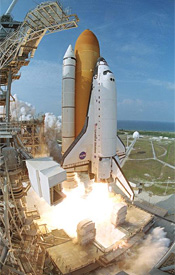 Image to right: A fish-eye view captures Space Shuttle Endeavour just after liftoff on mission STS-111. Credit: NASA
Image to right: A fish-eye view captures Space Shuttle Endeavour just after liftoff on mission STS-111. Credit: NASA
| T-9 minutes and counting
|
- Start automatic ground launch sequencer
- Retract orbiter access arm (T-7 minutes, 30 seconds)
- Start auxiliary power units (T-5 minutes, 0 seconds)
- Arm solid rocket booster range safety safe and arm devices (T-5 minutes, 0 seconds)
- Start orbiter aerosurface profile test, followed by main engine gimbal profile test (T-3 minutes, 55 seconds)
- Retract gaseous oxygen vent arm, or "beanie cap"
(T-2 minutes, 55 seconds)
- Crew members close and lock their visors
(T-2 minutes, 0 seconds)
- Orbiter transfers from ground to internal power
(T-50 seconds)
- Ground launch sequencer is go for auto sequence start (T-31 seconds)
- Activate launch pad sound suppression system
(T-16 seconds)
- Activate main engine hydrogen burnoff system
(T-10 seconds)
- Main engine start (T-6.6 seconds)
|
| T-0
|
- Solid rocket booster ignition and liftoff!
|
NASA's John F. Kennedy Space Center  The countdown clock is one of the most-watched timepieces in the world. On this page, you'll learn how the countdown operates, and what milestones to watch for during our live launch coverage.
The countdown clock is one of the most-watched timepieces in the world. On this page, you'll learn how the countdown operates, and what milestones to watch for during our live launch coverage. Image to right: The space shuttle launch team seated in Kennedy's Firing Room 1.
Image to right: The space shuttle launch team seated in Kennedy's Firing Room 1. Image to right: The rotating service structure is rolled slowly into the "park" position, revealing Space Shuttle Atlantis as the launch countdown for STS-98 enters its final hours. Credit: NASA
Image to right: The rotating service structure is rolled slowly into the "park" position, revealing Space Shuttle Atlantis as the launch countdown for STS-98 enters its final hours. Credit: NASA
 Image to right: A fish-eye view captures Space Shuttle Endeavour just after liftoff on mission STS-111. Credit: NASA
Image to right: A fish-eye view captures Space Shuttle Endeavour just after liftoff on mission STS-111. Credit: NASA